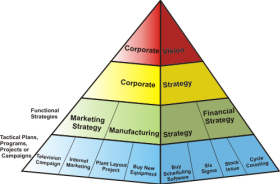What Is Strategy?
Strategy derives from the ancient Greek word strategos. Translated literally it meant "the general's art." In the past it referred primarily to military matters of an overall nature such as a major campaign or the overall conduct of a war. The 1950's and 1960's saw the word being applied to business operations by managers and academics who had served in the United States Army Air Force.


Strategy is about the forest, e.g., climate, topography and ecosystems.
Tactics is about trees— leaves, roots and bark.
In his 1955 work, The Practice of Management, Peter Drucker made the distinction between tactical decisions and strategic decisions. Others such as Kenneth R. Andrews, H. Igor Asoff, Alfred D. Chandler and Michael Porter developed structures, approaches, conventions and procedures for Corporate Strategy. Marketing Strategy, too, developed during this period standardizing terms and concepts such as "Target Marketing" and "segmentation."
Manufacturing Strategy had a late start and is still not well-known or taught as an essential in manufacturing curriculums. Yet, it is just as important as Marketing or Finance.
Conceptualizing Strategy
For all its common use, the concept of "strategy" remains slippery. It is generally agreed that long-term, difficult-to-change and wide-ranging issues are strategic. This is particularly true when the issues involve interactions with the environment.
Definitions
Harry Mintzberg offers five definitions, all of them useful in different contexts. Mintzberg's definitions are different views of a subtle and multi-faceted issue:
Strategy as a Plan
That is a consciously intended course of action. The Strategy-as-plan may be general or detailed, formal or in the mind. However, as a plan, strategy is conceived in advance, has a purpose and is thoughtful to some degree.
Strategy as a Perspective
Mintzburg points out that strategy may be a perspective, i.e. many people in the organization have the same orientation or perspective when they make strategic decisions. It is the same as "Strategy As A Plan" but without the formal planning. It also results in a predictable set of decisions and this relates to the "Strategy As a Pattern" definition.

S.S. United States—Blue Riband Holder Since 1951
A Great Vision Statement
We shall build good ships here
At a profit when we can
At a loss if we must
But, always, good ships.
-Newport News Shipbuilding & Dry-Dock Company
Strategy as a Pattern
A consistent pattern of decisions may be the result of an explicit and written strategy or it may result from organizational culture or it may result from the influence of one or more leaders. An inconsistent pattern of decisions also represents a sort of strategy--a disjointed, non-thinking, random, non-strategy, perhaps, but a strategy that governs decisions. So, in a sense, every organization has a strategy; they all make strategic decisions or non-decisions that are also decisions.
Strategy as a Position
We might also view strategy as a position relative to the environment. Company A, for example is well positioned to produce customized product for a narrow but lucrative market segment. Company B, in contrast, might be well positioned to produce standardize product for a large market segment. In a way, however, this is more the result of a strategy rather than the strategy itself.
Strategy as a Ploy
There are times when strategy becomes a ploy designed to provoke a competitor's reaction. For example, Company A might plan the development of a new facility hoping that Company B will thereby NOT develop a similar facility because of Company B's perceived risk of industry overcapacity. This aspect of strategy is relatively rare.
Levels of Strategy
The boundary between strategy and tactics is not always clear and strategy may be made at several levels. The top level being the most general and lower levels addressing more specific areas or functions until the lowest levels of strategy blend into tactics.
The strategic pyramid might start with a corporate vision statement. The vision statement for the former Newport News Shipbuilding & Dry-dock Company is an excellent example. The Corporate Strategy follows from the vision statement but is more specific. It might, for example specify a general class of ship by tonnage or purpose.
Next come the functional strategies such as Marketing, Manufacturing and Financial. These functional strategies are even more specific and should support the Corporate Strategy. Ideally, they coordinate with and mutually reinforce each other.
Functional strategies give rise to specific projects, plans, programs or campaigns that are tactical in nature but supportive of the functional strategy. Most training programs, a new plant layout or specific aspects of Six Sigma are tactical. For example, the Manufacturing Strategy may specify Cellular Manufacturing as a strategy and the new plant layout implements it.
When Tactical Is Strategic
When thinking of strategy as "Pattern" or "Position", the view is retrospective and the distinction is usually clear. But, when "Planning" or
"Perceptualizing" strategy, there can be difficulties as decisions may appear tactical at the time but, in retrospect years later, reveal themselves as
strategic and difficult to undo.
References & Further Reading
MOORE, J.I., Writers on Strategy & Strategic Management, Penguin Books, London, 1992.
■ ■ ■ ■ ■ ■ ■




